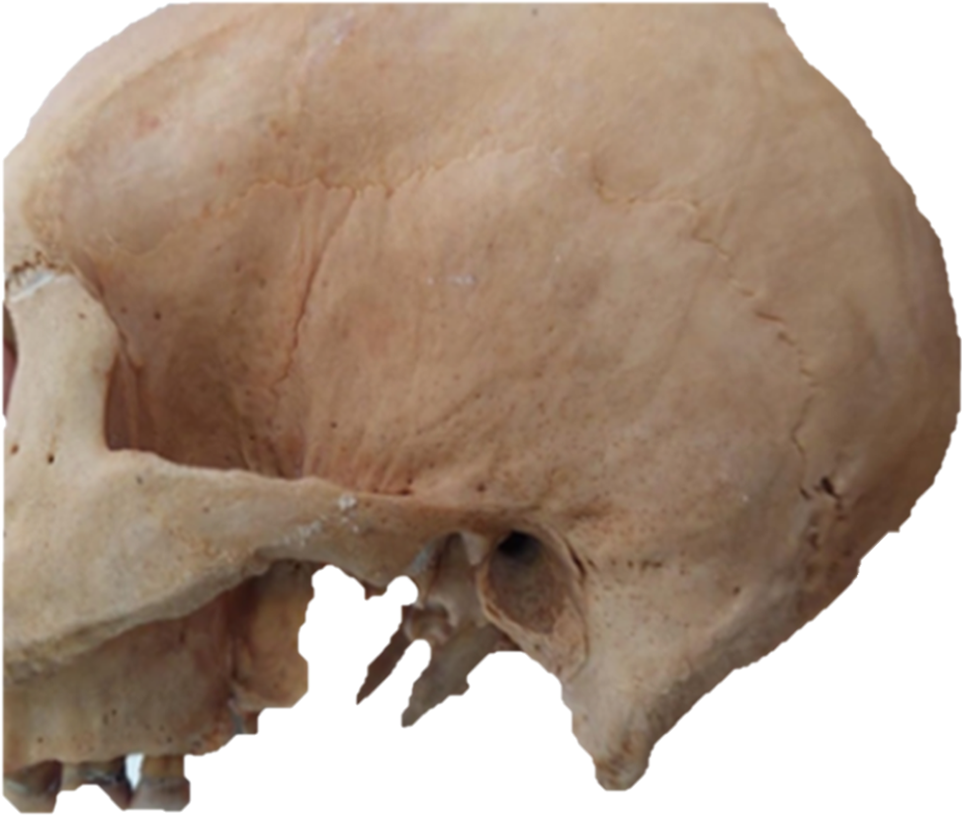Bilateral elongated styloid process: report of a dry skull
Main Article Content
Abstract
Temporal styloid process is a thin, fragile, pointed bony projection directed forward and downward with average length of 2 to 2.5 cm. The authors describe a skull with two enlarged styloid processes, found in the osteotheque of the Faculty of Medicine of the Eduardo Mondlane University. The objective of this presentation is to draw the attention of the medical community to the existence of these situations that in real life give different and non-specific symptoms that can make one think of another diagnosis. The clinical picture of Eagle's Syndrome ranges from asymptomatic cases to cases with great discomfort, with variable and non-specific symptoms, due to its close relationship with the vasculonervous bundle of the neck and other cranial nerves and its knowledge is important for the student of anatomy, anatomist, general practitioner, dentist, radiologist, neurologist, maxillofacial, neurosurgery, otolaryngologist and psychiatry.
Article Details

This work is licensed under a Creative Commons Attribution 4.0 International License.
Authors retain the copyright of their articles and grant the journal the right of first publication under the Creative Commons Attribution (CC BY) license, which allows others to share and adapt the work with proper attribution.
References
Rouviere H, Delmas A, Delmas V. Anatomia Humana Descriptiva, Topografica y Funcional Cabeza y Cuello. 11th ed. Vol. 1. Barcelona: Masson; 2005.
Nelluri V, Siddaraju KS. Anatomical and congenital variations of styloid process of temporal bone in Indian adult dry skull bones. Italian Journal of Anatomy and Embryology. 2019;124(3):509–16.
White T, M B, Folkens P. Human Osteology. 3rd ed. ELSEVIER. Elsevier Inc; 2012.
Rinaldi V, Meyers A. Eagle Syndrome. Medscape. 2022.
Riley DS, Barber MS, Kienle GS, Aronson JK, von Schoen-Angerer T, Tugwell P, Kiene H, Helfand M, Altman DG, Sox H, Werthmann PG, Moher D, Rison RA, Shamseer L, Koch CA, Sun GH, Hanaway P, Sudak NL, Kaszkin-Bettag M, Carpenter JE, Gagnier JJ. CARE guidelines for case reports: explanation and elaboration document. J Clin Epidemiol. 2017 May 18. pii: S0895-4356(17)30037-9. doi: 10.1016/j.jclinepi.2017.04.026.
Assiri Ahmed H, Estrugo-Devesa A, Roselló Llabrés X, Egido-Moreno S, López-López J. The prevalence of elongated styloid process in the population of Barcelona: a cross-sectional study & review of literature. BMC Oral Health [In-ternet]. 2023;23(1):1–11. Available from: https://doi.org/10.1186/s12903-023-03405-0.
Fonseca Balcázar F, Salinas Basauri J, Amaya Larios IY, Martínez Ronquillo A, Reyes MÁ. Prevalencia de apófisis estiloides elongada osificada y el síndrome de Eagle en la población que acude a la clínica de ortodoncia de CEDHUM. Revista Mexicana de Ortodoncia. 2022;7(3):152–8.
Muneera M, Hina M, Bukhari ZH, Kuraishi RT. Variations in length of styloid process in adult human dry skulls. 2021;71(4):1468–70.
Asutay F, Erdem NF, Atalay Y, Acar AH, Asutay H. Prevalence of Elongated Styloid Process and Eagle Syndrome in East Eagean Population. Bezmialem Science. 2019;7(1):28–32.
Al-Khanati NM, Taha DH, Kara Beit Z. Prevalence and Characteristics of Eagle’s Syndrome in a Syrian Population: A Cross-Sectional Descriptive Study. Cureus. 2023;15(9).
Lee KJ. Essential Otolaryngology. 9th ed. McGraw-Hill Companies; 2016. 1–1211 p.
Dhingra, P.L. Dhingra S. Eustachian tube and its disorder. 4th ed. Diseases of Ear, Nose & Throat, Elsevier.
Neto P. Síndrome de Eagle: aspectos radiográficos e implicações clínicas. Universidade Estadual de Campinas; 1999.
Bahgat M, Bahgat Y, Bahgat A. Eagle’s syndrome, a rare cause of neck pain. BMJ Case Rep. 2012;4–7.
